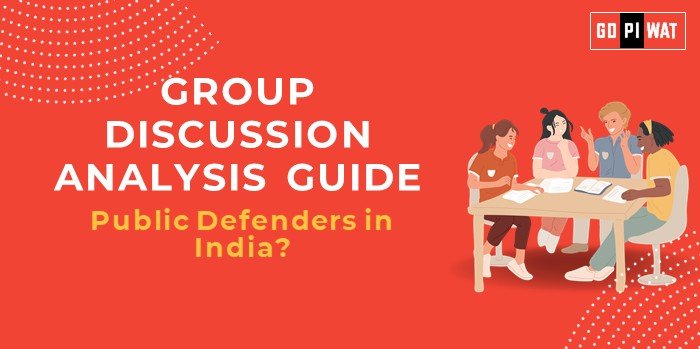📋 GD Analysis Guide: Public Defenders in India
🌐 Introduction to the Topic
- ⚖️ Opening Context: Public defenders play a crucial role in ensuring justice for underprivileged citizens. The debate around their adequacy in India gains significance as the judiciary grapples with case backlogs and systemic challenges.
- 📜 Topic Background: The public defender system is a cornerstone of legal aid in many democracies. In India, the Legal Services Authorities Act, 1987, institutionalized free legal aid. However, questions about the quality of representation persist.
📊 Quick Facts and Key Statistics
- 📂 Case Backlog: 4.4 crore cases pending in Indian courts (as of 2024) – reflecting strain on public defenders.
- 💰 Budget Allocation: ₹1,000 crore allocated for legal aid services (FY 2023-24).
- 👥 Beneficiaries: 8.8 million individuals received free legal aid under NALSA in 2023.
- ⚖️ Representation Gap: 1 public defender serves over 15,000 potential clients in urban areas.
👥 Stakeholders and Their Roles
- 🏛️ Government: Allocates funds, sets policies for legal aid.
- ⚖️ Judiciary: Monitors legal aid delivery and ensures fair trials.
- 🤝 NGOs: Complement government efforts through awareness and training.
- 👨👩👧👦 Citizens: Beneficiaries who need access and trust in the system.
🏆 Achievements and Challenges
✨ Achievements:
- 📈 NALSA Success: Expanded reach to rural and marginalized communities.
- 📱 Digital Innovations: Introduction of mobile apps and helplines for legal assistance.
- 📢 Awareness Campaigns: Boosted awareness about free legal aid, especially in tier-3 cities.
⚠️ Challenges:
- 🏢 Resource Constraints: Low budgets and understaffing hinder service quality.
- 📉 Competency Issues: Inconsistent training and skill levels among public defenders.
- 🌍 Global Comparisons: Systems like the UK and US provide higher lawyer-to-client ratios, ensuring better representation.
📖 Case Study:
- 📂 Delhi State Legal Services Authority: Demonstrates success in providing legal aid for minor crimes but struggles with complex cases.
🗣️ Structured Arguments for Discussion
- ✅ Supporting Stance: “Public defenders are a lifeline for marginalized communities, bridging access gaps in justice.”
- ❌ Opposing Stance: “Limited resources and systemic inefficiencies compromise the effectiveness of public defenders.”
- ⚖️ Balanced Perspective: “While public defenders offer critical services, significant reforms are essential for adequacy.”
💡 Effective Discussion Approaches
✨ Opening Approaches:
- 📊 Statistic Start: “Over 8.8 million people benefited from NALSA in 2023, yet questions about quality remain.”
- 📖 Cite a Case Study: “In Delhi, public defenders successfully resolved 70% of minor cases but faced challenges in appeals.”
🔄 Counter-Argument Handling:
- 🤝 “Resource constraints are valid, but public-private partnerships can bridge the gap.”
⚡ Strategic Analysis of Strengths and Weaknesses
- 💪 Strengths: Expanding reach, government commitment, technological integration.
- 🚫 Weaknesses: Low funding, lawyer shortages, inconsistent quality.
- 🚀 Opportunities: Digital platforms, better training, global collaborations.
- ⚠️ Threats: Public mistrust, high attrition among defenders, policy inertia.
📚 Connecting with B-School Applications
- 🏢 Real-World Applications:
- 📊 Relate to operations management in justice systems or policymaking for social impact.
- 🤔 Sample Interview Questions:
- ⚖️ “How can AI improve the efficiency of public defenders in India?”
- 📢 “What are the ethical implications of inadequate legal representation?”
- 💡 Insights for B-School Students:
- 📈 Explore legal aid as a policy innovation area.
- 🤝 Consider social entrepreneurship opportunities in legal access and awareness.


